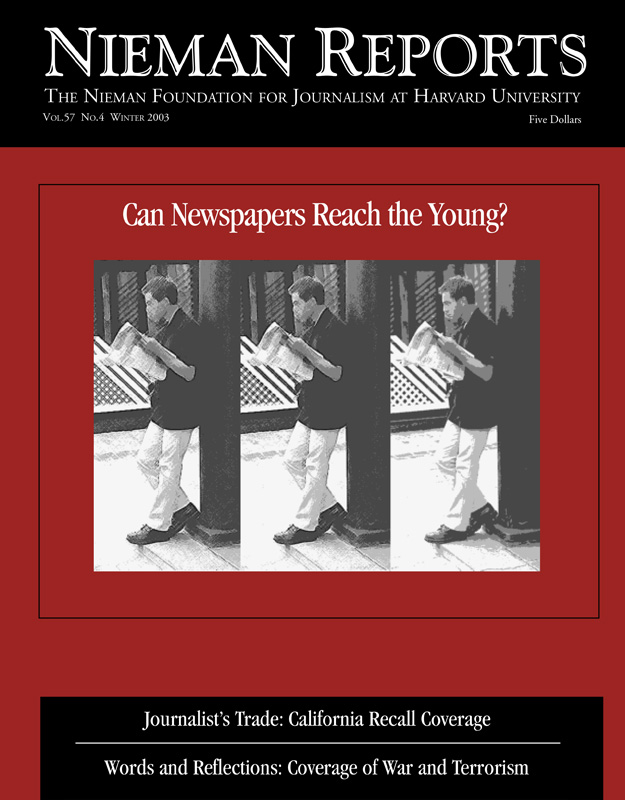The assignment was straightforward enough: Talk to people. Talk to people everywhere about California’s historic recall election. Not the pundits. Not the professors. Certainly not the politicians. Just “go find people,” hear them out, and take their pictures—an extended man/woman-on-the-street assignment, with “the street” being the 156,000-square-mile state of California.
So off we went. Beginning in early August, photographer José Luis Villegas and I steered away from the campaign trails—not once, in nine weeks of travel, did we cross paths with another journalist—probing the touchy question with voters of whether to throw Democrat Governor Gray Davis out of office and who, if it came to that, should replace him.
We talked to fishermen and farmers, bankers and beauticians, social workers and software execs. We met a woman chain-saw sculptor who turned redwood burls into art and a wisecracking small-town barber with a 99-year-old barber chair that came from a brothel. We met a disabled man living in a squalid shack in the Central Valley and a retired investment banker in San Francisco’s Pacific Heights with a million-dollar view.
Everyone, it seems, had an opinion. Unlike other news stories, whose specifics often elude large numbers of people, this story was as consuming to Californians as the O.J. Simpson trial had been nearly a decade earlier.
For all our diverse travels, it didn’t take long to uncover the essential truth about this election: Voters were steamed. The anger was palpable. There were the usual gripes—the budget deficit, the tripling of the vehicle tax, the controversial granting of driver’s licenses to illegal immigrants. But after that it got personal, with Davis at the core of a laundry list of grievances.
One mother held Davis directly responsible for her seven-year-old daughter’s special education class being cut. A community college student blamed him for her rising fees and inability to enroll in a chemistry class. A souvenir shop manager in Hollywood was ticked off about her lack of parking.
On and on the list grew, but to each problem the proposed remedy was the same: Throw the rascal out.
If recall backers were making Davis out to be the villain, to opponents of the recall, he remained almost an abstraction. In rural areas and in cities, even diehard recall opponents were loath to say they actually supported the governor. Instead they expressed philosophical objections to the recall—its expense, the Republican’s “power grab,” the futility of leadership change, but would just as quickly add: “Not that I like Davis.”
Hearing this chorus of complaint began to pose a journalistic challenge: to report what we were hearing might make it seem we were stacking the deck. So we looked harder for Davis supporters to provide some balance, but often came up short. We mixed up the story lineup, anticipating, for instance, that gay and lesbian voters in San Francisco would likely voice strong support for the governor, who had supported them on key issues. Instead, when we talked with them, we encountered widespread ambivalence. Many said they weren’t terribly interested in the recall election. “San Francisco is a very colorful city. It’s hard to have a governor as flavorless as Gray Davis,” explained a lesbian attorney.
By early September, having logged some 1,800 miles, one thing was obvious: Gray Davis was in trouble, big trouble. We didn’t have to say this—in story after story, the voters did.
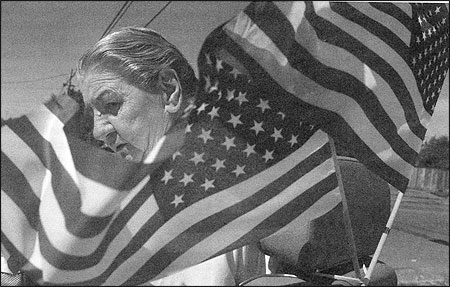
Margaret Gillhan of Pelican Bay, California, where a maximum-security prison is located, voiced anger about what happened with the town during Davis’s governorship. As Gillhan said, “This used to be a quiet little town,” but it has experienced “teenage troubles” from the children of the inmates’ families. Photo by José Luis Villegas/The Sacramento Bee.
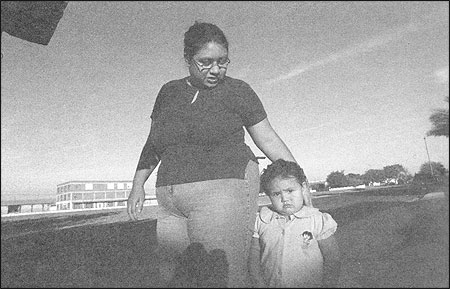
Rosemary Dominguez, with her two-year-old daughter Vanessa, intended to vote for the recall of Governor Gray Davis and for Cruz Bustamante for governor. Photo by José Luis Villegas/The Sacramento Bee.
Strategically Reporting on Voters
We knew none of this, of course, when our reporting journey began in early August. Back then, the greatest challenge seemed to be how to make the pieces unique and not repetitious—to avoid the coffee-shop peril. All too often, it seems, journalists take the easy route on these kinds of assignments, blowing into a community, locating the town “hang-out,” and quizzing a handful of patrons while discreetly gathering colorful anecdotes about the tablecloths and quaint wall hangings to give each piece a sense of place.
But this election, and this state, were far more complex than that. As the nation’s most populous state, and the third largest geographically, California is a place where diversity is measured not just by race and ethnicity, but by many other factors: socio-economics, sexual orientation, language and culture, urban vs. rural, young and old, newcomer vs. old-timer.
To truly capture these wide-ranging voices, and to distinguish the pieces, we had to spurn the journalistic tradition of the mom-and-pop café—of hitting the road and winging it. We had to have a plan, a strategy for where we were going and why. With meticulous front-end research by Bee librarian Pete Basofin, who crunched and re-crunched statewide data and rifled through dusty political annuals, we sketched out our targets before we left home.
There was Placer County in the Sacramento region, for instance, a Republican stronghold that had collected the highest percentage of recall signatures of any county in the state. Later, we would visit heavily Democrat San Francisco, the county that had returned the lowest percentage of recall signatures. We traveled to remote Modoc County on the Oregon and Nevada borders, where median household income is the lowest in the state.
And we spent time in Merced County in the San Joaquin Valley, where small dairy farms and lush orchards are giving way overnight to model homes and new Starbucks. As demographics have shifted throughout the Valley, Merced remains one of the last counties where Democrats still hold a slight edge over Republicans, though Republicans often prove to be more reliable voters.
These particular aspects about various locales helped frame the stories, giving readers a fresh context for each installment in the series. With Basofin’s help, the stories contained not only colorful characters talking about the recall and what it meant to them, but also plenty of rich detail about the areas and their historical and political significance.
Not all the pieces were defined by interesting demographics or political patterns. Some places were simply chosen as backdrops for specific subjects. For instance, we wanted to talk with prison guards—one of Davis’s controversial constituencies, as he upped their pay during his leadership (then later tried to renege). For this we traveled to Crescent City near the Oregon border, home of the notorious Pelican Bay State Prison, where the maximum-security prison has not always enjoyed an easy marriage with the small coastal town.
Meanwhile, women’s rights activists, supportive of Davis, struggled to be heard over the clang-clang of voters’ fiscal alarm. For this perspective, we went to Fresno County in the Central Valley, where teen birth rates are the highest in the state—and actually cost taxpayers the most money. We used San Diego as the backdrop for a talk-radio story, focusing on conservative talk-show host and former mayor, Roger Hedgecock, an early recall supporter who whipped up local voters with “drive-by” petition signings. And just for fun, we hit San Diego’s popular Tourmaline Surfing Park, where aging surfers defied the loopy, checked-out dude image and plunged into articulate, reasoned discussions about the recall.
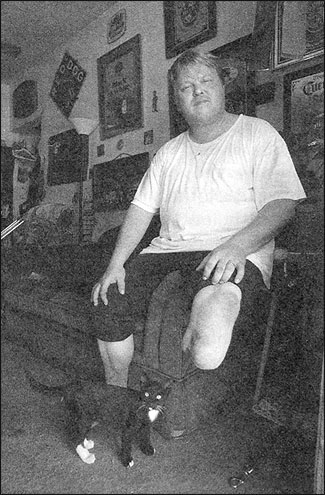
Jewell Charles blamed California Governor Gray Davis and the U.S. Government for the state of the economy. Photo by José Luis Villegas/The Sacramento Bee.
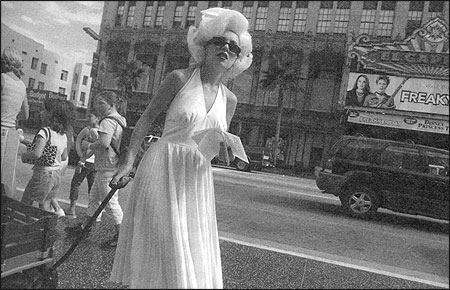
Dara Morehouse, dressed like Marilyn Monroe and pulling a wagon, takes flyers to Grauman’s Chinese Theatre. Photo by José Luis Villegas/The Sacramento Bee.
Moving Beyond Assumptions
The surfers went against stereotype—one of the biggest traps I believe journalists can fall into on these kinds of assignments. With limited time in unknown places, there is a tendency to over-generalize—to make sweeping conclusions about a whole region or group of people, based on a day or two of interviewing.
As a 2001 Ethics Fellow at The Poynter Institute in St. Petersburg, Florida, I wrote a paper about what I call “geographic bias,” an affliction suffered most commonly by national reporters. The journalists, who parachute into strange places at a moment’s notice, routinely try to help readers and viewers get oriented with scene-setting or contextual stories—a worthy goal, except when the work ends up being one-dimensional or even twisted.
Rural areas are the most susceptible, probably because they are the most foreign to urban journalists— and seem so quaint and simple to the untrained eye. As a native Nebraskan, I cringe every four years during the presidential caucuses in Iowa and the predictable romps around farm country. Never mind that Iowa’s political decisions are driven by its urban areas. Never mind that Des Moines is one of the world’s busiest insurance centers. Do we ever see Iowa people in suits and ties? Instead, we are constantly treated to footage of folksy farmers and rippling ripe cornfields, despite the fact that a cornfield in Iowa in January is nothing more than frozen stubble.
Where there is “geographic bias” by journalists, stereotypes abound. In rural areas, for instance, the regulars at the local steakhouse suddenly become the voice for the whole community or even state. The images from the barbershop or bingo parlor are portrayed as the sum of life here.
On our travels, José and I vowed to avoid that trap and developed a mantra to keep us grounded: “It is what it is,” we said over and over. At first, it was a response to weariness as we crawled inside the car after another long day of stalking and stopping strangers or getting chased by farm dogs. But I think over time it reminded us not to overreach—not to even try to write the “definitive” piece about an area after only spending a day or two in it. Yet it was our journalistic instinct to try and say something profound, to extract some deeper meaning in every story, but the reality and time limitations of the assignment dictated otherwise.
It was what it was.
And it was important. People in California had a lot to say about this election, and their voices added immeasurably to the overall coverage. Because in the end, it wasn’t the political experts or talking heads who decided Davis’s fate. It was Rose at the General Store in Likely (population 200), who had been soaking up the buzz behind the cash register and knew Davis was done-for. It was Maryanne, a waitress at a Los Banos lunch counter, who blamed Davis for her customers’ inability to pay for a decent breakfast. And it was Edwin, a Fresno State college student mad about rising tuition and enamored with Arnold Schwarzenegger’s “celebrity appeal.”
These voices mattered most because they’re the ones who decided October 7—all 8,984,057 of them.
The people had spoken. It was a privilege to listen.
Marjie Lundstrom is a senior editor, columnist and writing coach for The Sacramento Bee, where she has also been city editor, metro editor, and assistant managing editor/metro. In 1991, while a national correspondent with Gannett News Service, she won the 1991 Pulitzer Prize for national reporting for a groundbreaking series of stories revealing how child-abuse deaths went undetected because of mistakes by medical examiners and coroners.
So off we went. Beginning in early August, photographer José Luis Villegas and I steered away from the campaign trails—not once, in nine weeks of travel, did we cross paths with another journalist—probing the touchy question with voters of whether to throw Democrat Governor Gray Davis out of office and who, if it came to that, should replace him.
We talked to fishermen and farmers, bankers and beauticians, social workers and software execs. We met a woman chain-saw sculptor who turned redwood burls into art and a wisecracking small-town barber with a 99-year-old barber chair that came from a brothel. We met a disabled man living in a squalid shack in the Central Valley and a retired investment banker in San Francisco’s Pacific Heights with a million-dollar view.
Everyone, it seems, had an opinion. Unlike other news stories, whose specifics often elude large numbers of people, this story was as consuming to Californians as the O.J. Simpson trial had been nearly a decade earlier.
For all our diverse travels, it didn’t take long to uncover the essential truth about this election: Voters were steamed. The anger was palpable. There were the usual gripes—the budget deficit, the tripling of the vehicle tax, the controversial granting of driver’s licenses to illegal immigrants. But after that it got personal, with Davis at the core of a laundry list of grievances.
One mother held Davis directly responsible for her seven-year-old daughter’s special education class being cut. A community college student blamed him for her rising fees and inability to enroll in a chemistry class. A souvenir shop manager in Hollywood was ticked off about her lack of parking.
On and on the list grew, but to each problem the proposed remedy was the same: Throw the rascal out.
If recall backers were making Davis out to be the villain, to opponents of the recall, he remained almost an abstraction. In rural areas and in cities, even diehard recall opponents were loath to say they actually supported the governor. Instead they expressed philosophical objections to the recall—its expense, the Republican’s “power grab,” the futility of leadership change, but would just as quickly add: “Not that I like Davis.”
Hearing this chorus of complaint began to pose a journalistic challenge: to report what we were hearing might make it seem we were stacking the deck. So we looked harder for Davis supporters to provide some balance, but often came up short. We mixed up the story lineup, anticipating, for instance, that gay and lesbian voters in San Francisco would likely voice strong support for the governor, who had supported them on key issues. Instead, when we talked with them, we encountered widespread ambivalence. Many said they weren’t terribly interested in the recall election. “San Francisco is a very colorful city. It’s hard to have a governor as flavorless as Gray Davis,” explained a lesbian attorney.
By early September, having logged some 1,800 miles, one thing was obvious: Gray Davis was in trouble, big trouble. We didn’t have to say this—in story after story, the voters did.

Margaret Gillhan of Pelican Bay, California, where a maximum-security prison is located, voiced anger about what happened with the town during Davis’s governorship. As Gillhan said, “This used to be a quiet little town,” but it has experienced “teenage troubles” from the children of the inmates’ families. Photo by José Luis Villegas/The Sacramento Bee.

Rosemary Dominguez, with her two-year-old daughter Vanessa, intended to vote for the recall of Governor Gray Davis and for Cruz Bustamante for governor. Photo by José Luis Villegas/The Sacramento Bee.
Strategically Reporting on Voters
We knew none of this, of course, when our reporting journey began in early August. Back then, the greatest challenge seemed to be how to make the pieces unique and not repetitious—to avoid the coffee-shop peril. All too often, it seems, journalists take the easy route on these kinds of assignments, blowing into a community, locating the town “hang-out,” and quizzing a handful of patrons while discreetly gathering colorful anecdotes about the tablecloths and quaint wall hangings to give each piece a sense of place.
But this election, and this state, were far more complex than that. As the nation’s most populous state, and the third largest geographically, California is a place where diversity is measured not just by race and ethnicity, but by many other factors: socio-economics, sexual orientation, language and culture, urban vs. rural, young and old, newcomer vs. old-timer.
To truly capture these wide-ranging voices, and to distinguish the pieces, we had to spurn the journalistic tradition of the mom-and-pop café—of hitting the road and winging it. We had to have a plan, a strategy for where we were going and why. With meticulous front-end research by Bee librarian Pete Basofin, who crunched and re-crunched statewide data and rifled through dusty political annuals, we sketched out our targets before we left home.
There was Placer County in the Sacramento region, for instance, a Republican stronghold that had collected the highest percentage of recall signatures of any county in the state. Later, we would visit heavily Democrat San Francisco, the county that had returned the lowest percentage of recall signatures. We traveled to remote Modoc County on the Oregon and Nevada borders, where median household income is the lowest in the state.
And we spent time in Merced County in the San Joaquin Valley, where small dairy farms and lush orchards are giving way overnight to model homes and new Starbucks. As demographics have shifted throughout the Valley, Merced remains one of the last counties where Democrats still hold a slight edge over Republicans, though Republicans often prove to be more reliable voters.
These particular aspects about various locales helped frame the stories, giving readers a fresh context for each installment in the series. With Basofin’s help, the stories contained not only colorful characters talking about the recall and what it meant to them, but also plenty of rich detail about the areas and their historical and political significance.
Not all the pieces were defined by interesting demographics or political patterns. Some places were simply chosen as backdrops for specific subjects. For instance, we wanted to talk with prison guards—one of Davis’s controversial constituencies, as he upped their pay during his leadership (then later tried to renege). For this we traveled to Crescent City near the Oregon border, home of the notorious Pelican Bay State Prison, where the maximum-security prison has not always enjoyed an easy marriage with the small coastal town.
Meanwhile, women’s rights activists, supportive of Davis, struggled to be heard over the clang-clang of voters’ fiscal alarm. For this perspective, we went to Fresno County in the Central Valley, where teen birth rates are the highest in the state—and actually cost taxpayers the most money. We used San Diego as the backdrop for a talk-radio story, focusing on conservative talk-show host and former mayor, Roger Hedgecock, an early recall supporter who whipped up local voters with “drive-by” petition signings. And just for fun, we hit San Diego’s popular Tourmaline Surfing Park, where aging surfers defied the loopy, checked-out dude image and plunged into articulate, reasoned discussions about the recall.

Jewell Charles blamed California Governor Gray Davis and the U.S. Government for the state of the economy. Photo by José Luis Villegas/The Sacramento Bee.

Dara Morehouse, dressed like Marilyn Monroe and pulling a wagon, takes flyers to Grauman’s Chinese Theatre. Photo by José Luis Villegas/The Sacramento Bee.
Moving Beyond Assumptions
The surfers went against stereotype—one of the biggest traps I believe journalists can fall into on these kinds of assignments. With limited time in unknown places, there is a tendency to over-generalize—to make sweeping conclusions about a whole region or group of people, based on a day or two of interviewing.
As a 2001 Ethics Fellow at The Poynter Institute in St. Petersburg, Florida, I wrote a paper about what I call “geographic bias,” an affliction suffered most commonly by national reporters. The journalists, who parachute into strange places at a moment’s notice, routinely try to help readers and viewers get oriented with scene-setting or contextual stories—a worthy goal, except when the work ends up being one-dimensional or even twisted.
Rural areas are the most susceptible, probably because they are the most foreign to urban journalists— and seem so quaint and simple to the untrained eye. As a native Nebraskan, I cringe every four years during the presidential caucuses in Iowa and the predictable romps around farm country. Never mind that Iowa’s political decisions are driven by its urban areas. Never mind that Des Moines is one of the world’s busiest insurance centers. Do we ever see Iowa people in suits and ties? Instead, we are constantly treated to footage of folksy farmers and rippling ripe cornfields, despite the fact that a cornfield in Iowa in January is nothing more than frozen stubble.
Where there is “geographic bias” by journalists, stereotypes abound. In rural areas, for instance, the regulars at the local steakhouse suddenly become the voice for the whole community or even state. The images from the barbershop or bingo parlor are portrayed as the sum of life here.
On our travels, José and I vowed to avoid that trap and developed a mantra to keep us grounded: “It is what it is,” we said over and over. At first, it was a response to weariness as we crawled inside the car after another long day of stalking and stopping strangers or getting chased by farm dogs. But I think over time it reminded us not to overreach—not to even try to write the “definitive” piece about an area after only spending a day or two in it. Yet it was our journalistic instinct to try and say something profound, to extract some deeper meaning in every story, but the reality and time limitations of the assignment dictated otherwise.
It was what it was.
And it was important. People in California had a lot to say about this election, and their voices added immeasurably to the overall coverage. Because in the end, it wasn’t the political experts or talking heads who decided Davis’s fate. It was Rose at the General Store in Likely (population 200), who had been soaking up the buzz behind the cash register and knew Davis was done-for. It was Maryanne, a waitress at a Los Banos lunch counter, who blamed Davis for her customers’ inability to pay for a decent breakfast. And it was Edwin, a Fresno State college student mad about rising tuition and enamored with Arnold Schwarzenegger’s “celebrity appeal.”
These voices mattered most because they’re the ones who decided October 7—all 8,984,057 of them.
The people had spoken. It was a privilege to listen.
Marjie Lundstrom is a senior editor, columnist and writing coach for The Sacramento Bee, where she has also been city editor, metro editor, and assistant managing editor/metro. In 1991, while a national correspondent with Gannett News Service, she won the 1991 Pulitzer Prize for national reporting for a groundbreaking series of stories revealing how child-abuse deaths went undetected because of mistakes by medical examiners and coroners.
